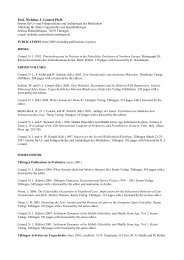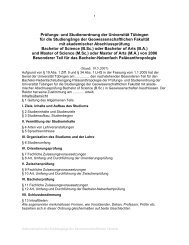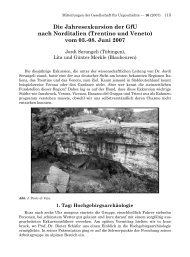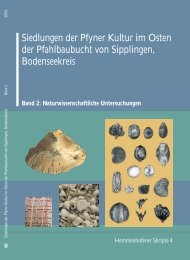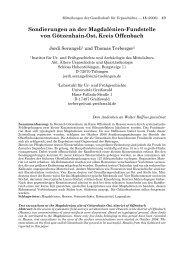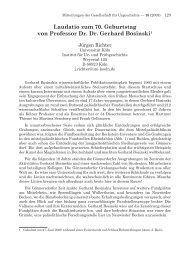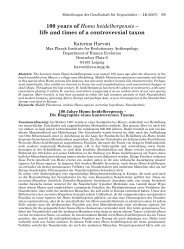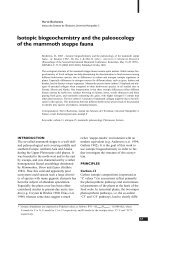bronze age environment and economy in the troad - Universität ...
bronze age environment and economy in the troad - Universität ...
bronze age environment and economy in the troad - Universität ...
You also want an ePaper? Increase the reach of your titles
YUMPU automatically turns print PDFs into web optimized ePapers that Google loves.
chapter 2: methods<br />
In Near Eastern countries, where trees <strong>and</strong> wood are valuable<br />
raw materials, people make <strong>in</strong>tensive use of <strong>the</strong> maquis,<br />
garrigue <strong>and</strong> batha, <strong>and</strong> o<strong>the</strong>r alternative fuel sources. For<br />
example, Sarcopoterium sp<strong>in</strong>osum <strong>and</strong> o<strong>the</strong>r sp<strong>in</strong>y plants are<br />
important fuels, alongside <strong>the</strong> use as fuel of dung <strong>and</strong> waste<br />
products from cereal process<strong>in</strong>g, or a draff mixture from olive<br />
oil <strong>and</strong> w<strong>in</strong>e production (Hepper 1992). With <strong>the</strong> early open<strong>in</strong>g<br />
of <strong>the</strong> vegetation <strong>and</strong> <strong>in</strong>tensive charcoal fabrication for metal<br />
production, at least <strong>in</strong> Late Bronze Age, one might imag<strong>in</strong>e that<br />
a few of <strong>the</strong> shrubby plants came <strong>in</strong>to <strong>the</strong> settlement as fuel.<br />
Consider<strong>in</strong>g <strong>the</strong> high value of wood for different craft purposes<br />
<strong>and</strong> <strong>the</strong> early decl<strong>in</strong>e of Mediterranean woodl<strong>and</strong>s, it seems<br />
likely that people used alternative fuel sources for cook<strong>in</strong>g <strong>and</strong><br />
heat<strong>in</strong>g from <strong>the</strong> earliest days.<br />
The sp<strong>in</strong>y plants, which are numerous <strong>in</strong> several plant families<br />
<strong>in</strong> Near Eastern countries, have been important sources of fuel<br />
s<strong>in</strong>ce at least biblical times. In particular, Sarcopoterium<br />
sp<strong>in</strong>osum, a characteristic plant of maquis, garrigue <strong>and</strong> batha,<br />
which is not browsed by animals, is cut <strong>and</strong> collected today <strong>in</strong><br />
Near Eastern countries (Seçmen <strong>and</strong> Leblebici 1978, p. 227).<br />
Not only sp<strong>in</strong>y plants, but all dry vegetative plant material is<br />
used for fuel, such as brushwood from fruit-tree prun<strong>in</strong>g, chaff<br />
rema<strong>in</strong>s from crop-process<strong>in</strong>g, etc.. In addition, vegetative<br />
material rich <strong>in</strong> oil was always used for fuel. Olive <strong>and</strong> grape<br />
draff, for example, are known to be burnt toge<strong>the</strong>r (Hepper<br />
1992).<br />
Today dung is still a welcome fuel, ma<strong>in</strong>ly <strong>in</strong> arid <strong>and</strong> treeless<br />
regions. The importance of dung <strong>in</strong> <strong>the</strong> formation of<br />
archaeobotanical contexts has only recently been discussed.<br />
Some archaeobotanists conclude that dung used as fuel was <strong>the</strong><br />
ma<strong>in</strong> source of carbonised plant rema<strong>in</strong>s at <strong>the</strong>ir sites (e.g.<br />
Miller 1984, Miller <strong>and</strong> Smart 1984, Bottema 1984).<br />
Ethnographic <strong>in</strong>vestigations reveal <strong>the</strong> importance of dung as a<br />
fuel, not least by <strong>the</strong> tradition along with dung cake preparation<br />
<strong>and</strong> preferences <strong>in</strong> <strong>the</strong> use of it. Different k<strong>in</strong>ds of dung cakes<br />
exist, accord<strong>in</strong>g to <strong>the</strong>ir seasonal orig<strong>in</strong>, <strong>the</strong> preparation<br />
method, <strong>and</strong> <strong>the</strong> animals <strong>the</strong>y derive from. Amongst <strong>the</strong> six<br />
different types of dung cakes that are listed by Anderson<br />
(1995) <strong>the</strong> compacted sheep dung cut from byres (sarma) has<br />
<strong>the</strong> best burn<strong>in</strong>g qualities. Summer sheep dropp<strong>in</strong>gs can also be<br />
swept up <strong>and</strong> moulded <strong>in</strong>to a ‛bun’ shape. Kerpiç, which was<br />
found <strong>in</strong> relation with <strong>the</strong> architecture <strong>in</strong> Troy, is early summer<br />
cow dung compacted <strong>in</strong>to a mould, whereas Kerme is w<strong>in</strong>ter<br />
cow dung, compacted <strong>and</strong> cut <strong>in</strong>to bricks. The preparation<br />
method, whereby additional plant material is mixed <strong>in</strong>to <strong>the</strong><br />
dung cake, is generally assumed to give poorer burn<strong>in</strong>g quality,<br />
<strong>and</strong> may affect <strong>the</strong> <strong>in</strong>terpretation of archaeobotanical samples<br />
as dung rema<strong>in</strong>s (Miller 1984). Amongst <strong>the</strong> plants that are<br />
used as t<strong>in</strong>der, <strong>and</strong> are collected <strong>and</strong> dried for this purpose, are<br />
Astragalus sp., Juncus <strong>in</strong>flexus, Phragmites australis, Salix <strong>and</strong><br />
Vitis v<strong>in</strong>ifera branches (Anderson 1995).<br />
The <strong>in</strong>terpretation of archaeobotanical macrofossils as dung or<br />
fodder rema<strong>in</strong>s, especially <strong>in</strong> English literature, leads not only<br />
to economic <strong>and</strong> ecological conclusions (deforestation), but<br />
also to <strong>the</strong> reconstruction of <strong>the</strong> social <strong>environment</strong>, because of<br />
<strong>the</strong> connection of fuel scarcity with economic poverty (Fenton<br />
1985). Additionally, when used as fuel, <strong>the</strong> dung is lost for<br />
purposes such as fertiliser. The sociopolitical aspects of us<strong>in</strong>g<br />
dung for fuel are sometimes expressed <strong>in</strong> <strong>the</strong> concept of some<br />
k<strong>in</strong>d of ownership of <strong>the</strong> dung by <strong>the</strong> shepherd (Anderson<br />
1995).<br />
The palynological, archaeozoological <strong>and</strong> archaeological<br />
results from Troy (Gennett <strong>and</strong> Gifford 1982, Uerpmann,<br />
Köhler <strong>and</strong> Stephan 1992) suggest that dung was an important<br />
source of archaeobotanical rema<strong>in</strong>s. The wild plant species, not<br />
associated with <strong>the</strong> crops, <strong>and</strong> which were thought to derive<br />
from animal feed or dung, were evaluated for <strong>the</strong>ir suitability<br />
for cattle or for sheep/goat nutrition. It has to be assumed that<br />
<strong>the</strong> different grow<strong>in</strong>g heights of <strong>the</strong>se species make <strong>the</strong>m<br />
variously accessible to animals. Due to <strong>the</strong>ir masticatory<br />
apparatus <strong>and</strong> carri<strong>age</strong>, cows are adapted to graz<strong>in</strong>g taller herbs<br />
(<strong>the</strong>y are not able to pull up short grasses with <strong>the</strong>ir tongue),<br />
while sheep tend to graze on lower vegetation layers. Goats are<br />
a special case, with <strong>the</strong> ability to browse on trees. An<br />
assembl<strong>age</strong> dom<strong>in</strong>ated by low-grow<strong>in</strong>g potential fodder plants<br />
should <strong>in</strong>dicate that <strong>the</strong> rema<strong>in</strong>s <strong>in</strong> question are probably<br />
derived from sheep dung ra<strong>the</strong>r than from cattle.<br />
In most archaeological contexts with unknown formation<br />
processes <strong>the</strong>re seems to be no def<strong>in</strong>itive way of identify<strong>in</strong>g<br />
dung samples from <strong>the</strong> plant macro-rema<strong>in</strong>s alone. In some<br />
exceptional cases it might be possible (as for <strong>the</strong> rema<strong>in</strong>s older<br />
than Troy I, <strong>in</strong> trench D5, see chapter 3.2.2.1). Investigations of<br />
<strong>the</strong> survival of plant seeds dur<strong>in</strong>g digestion have been ma<strong>in</strong>ly<br />
conducted by agronomists, e.g. to assess whe<strong>the</strong>r or not cattle<br />
were responsible for <strong>the</strong> spread of weeds on farm l<strong>and</strong> (e.g.<br />
Atkeson, Hulbert <strong>and</strong> Warren 1934, Burton <strong>and</strong> Andrews 1948,<br />
Russi, Cocks <strong>and</strong> Roberts 1992, Gardener, McIvor <strong>and</strong> Jansen<br />
1993, Malo <strong>and</strong> Suárez 1995), whereas syn- <strong>and</strong><br />
postdepositional taphonomic <strong>in</strong>fluences on dung fuel has<br />
ma<strong>in</strong>ly been studied by archaeobotanists (e.g. McLaughl<strong>in</strong><br />
Smith 1990).<br />
The taphonomic processes that lead to <strong>the</strong> formation of dung<br />
cakes are relatively complicated. Food selection by animals<br />
<strong>and</strong> humans <strong>and</strong> digestion are <strong>the</strong> most important filters<br />
between <strong>the</strong> available plants <strong>in</strong> <strong>the</strong> <strong>environment</strong> <strong>and</strong> <strong>the</strong> seeds<br />
<strong>in</strong> animal dung.<br />
Consider<strong>in</strong>g feed selection by animals, one recognises that<br />
digestibility rema<strong>in</strong>s high until <strong>the</strong> onset of flower<strong>in</strong>g (Arnold<br />
1964). Taste, smell, toxicity <strong>and</strong> physical protection of a plant<br />
affect its palatability. Spikes <strong>and</strong> thorns offer plants a form of<br />
physical protection from predation, but animals may still target<br />
<strong>the</strong>se plants due to a lack of alternatives.<br />
Selection by humans concerns whole vegetation units or <strong>the</strong><br />
composition of fodder. The different areas <strong>and</strong> different<br />
households Anderson (1995) observed, used different<br />
husb<strong>and</strong>ry regimes. Sheep herders kept <strong>the</strong> animals <strong>in</strong>side<br />
dur<strong>in</strong>g <strong>the</strong> w<strong>in</strong>ter <strong>and</strong> fed <strong>the</strong>m on a comb<strong>in</strong>ation of cereals,<br />
legumes <strong>and</strong> crop-process<strong>in</strong>g residues. Fodder can also be <strong>in</strong><br />
<strong>the</strong> form of fresh or stored herb<strong>age</strong>, or even fruits such as dried<br />
grapes, which are fed to <strong>the</strong> rams before <strong>the</strong> mat<strong>in</strong>g season.<br />
Although mature herb<strong>age</strong> is <strong>the</strong> least nutritious (Fishwick<br />
1952, Jones <strong>and</strong> Wilson 1987), it is likely to be stored as fodder<br />
<strong>in</strong> this form. This also means that hay is likely to be cut around<br />
<strong>the</strong> seed-bear<strong>in</strong>g st<strong>age</strong>, which may <strong>in</strong>crease <strong>the</strong> chance of seeds<br />
enter<strong>in</strong>g <strong>the</strong> animal dung through fodder. As mentioned before,<br />
crop-process<strong>in</strong>g residues are also an important source of animal<br />
fodder. Such residues are not very nutritious, but <strong>the</strong><br />
digestibility of straw can be improved by supplement<strong>in</strong>g <strong>the</strong><br />
25





